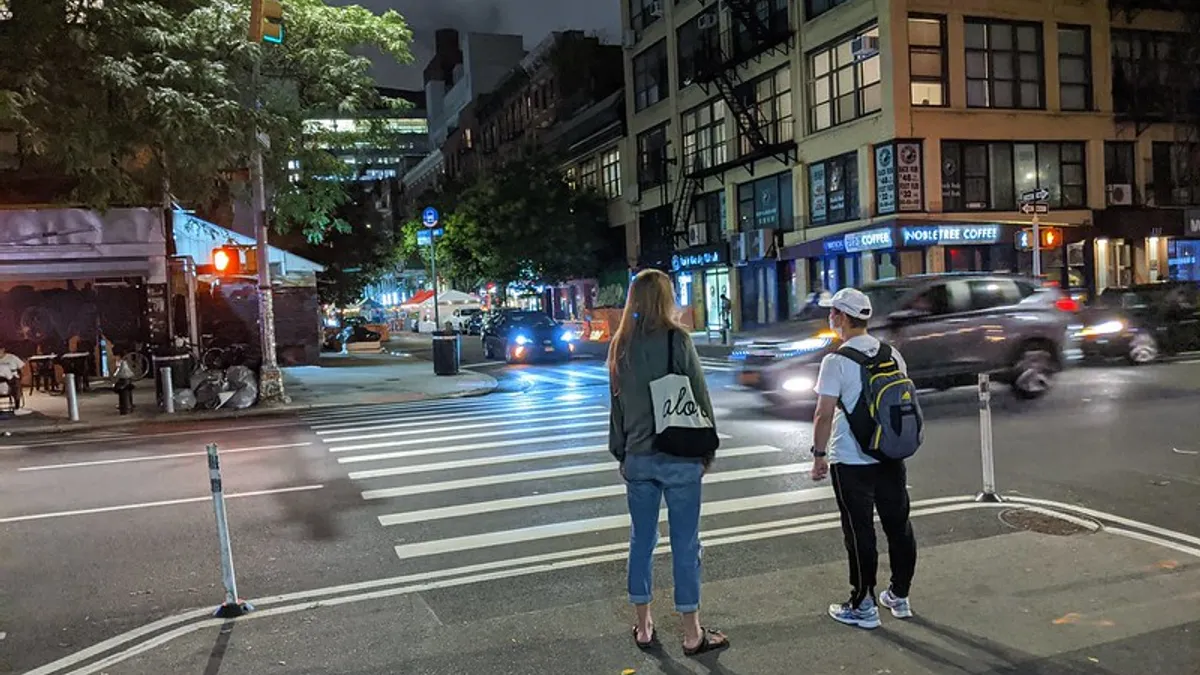Dive Brief:
- A series of Florida metropolitan areas saw the highest rate of pedestrian activity in 2020, according to a StreetLight Data analysis of the 100 largest U.S. cities. Orlando-Kissimmee-Sanford, FL; Cape Coral-Fort Myers, FL; and Palm Bay-Melbourne-Titusville, FL topped the list.
- Walking in city centers or downtowns remained high throughout the pandemic, and fluctuated just 10% compared to 2019. But the rate of pedestrian activity outside of city centers saw the most dramatic changes in 2020 compared to 2019, with some pedestrian activity increasing or decreasing by up to 100%.
- In the Orlando area, for example, pedestrians were 19 times more likely to be hit by a driver in the surrounding Holden Heights area compared to Orlando's city center.
Dive Insight:
The pandemic and its influx of congestion-free roads in some areas created a less safe pedestrian experience, having ushered in a period of reckless driving in which motorists traveled at faster, deadlier speeds. Drivers increased their speeds in certain areas by up to 42% in 2020.
And according to a recent report from Smart Growth America, the number of people struck and killed by drivers rose by 45% over the past decade. In fact, the Orlando metropolitan area was also recently ranked as the most dangerous city for pedestrians, followed by Bakersfield, CA and Memphis, TN.
Of the 20 most dangerous areas for pedestrians identified in the SGA report, nine were in Florida. Likewise, StreetLight Data's report lists eight Florida metro areas among its top 20 cities for pedestrian activity.
There are also significant racial disparities in the number of pedestrian deaths. Black pedestrians are killed at a rate 82% higher than White, non-Hispanic pedestrians, according to the SGA report. Individuals walking in lower-income neighborhoods are also far more likely to be killed by drivers.
The drastic change in pedestrian activity during the pandemic — particularly in the suburbs or areas surrounding city centers — has created new challenges for transportation planners, according to StreetLight Data Director of Content Marketing Phaedra Hise.
And as local leaders and transportation planners try to create safer streets for pedestrians, they should not rely on old data, "because pedestrian activity has changed significantly," the report writes. Similarly, planners should be hesitant to model suburban pedestrian activity based on urban data, the report reads.
COVID-19 has changed so much that planners should really monitor their data in an ongoing way, Hise said.
To make streets safer, local leaders should consider lowering speeds, narrowing travel lanes, adding crosswalks and avoiding broad curves at intersections. And as more urban and suburban residents turn to cycling, some city leaders have embraced simple tactical urbanism efforts like "pop-up bike lanes" or widened sidewalks as an inexpensive but effective way to keep cyclists safe.












